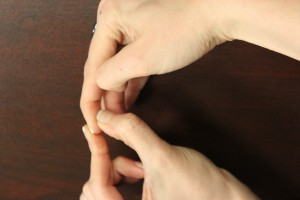
Mallet Finger: A Common Sports Injury
1 CommentFrom a high level competition to a weekend pick-up game, any athlete can experience a hand injury. Bumping, jamming, crushing, or cutting the backside of the finger near the tip, can cause a tendon injury known as a mallet finger.
 Mallet finger occurs when there is a disruption in the tendon that straightens the tip of the finger. When the tendon is damaged, cut, or avulsed (ripped from bone) the tip of the finger will drop down without the ability to straighten. The remaining joints of the finger are still able to extend. Should you or a teammate experience this, seek treatment from your local physician. They will determine bone involvement and whether the injury can be treated conservatively, or if it may require surgical intervention.
Mallet finger occurs when there is a disruption in the tendon that straightens the tip of the finger. When the tendon is damaged, cut, or avulsed (ripped from bone) the tip of the finger will drop down without the ability to straighten. The remaining joints of the finger are still able to extend. Should you or a teammate experience this, seek treatment from your local physician. They will determine bone involvement and whether the injury can be treated conservatively, or if it may require surgical intervention.
Nonsurgical Treatment Options for Mallet Finger
Conservative Treatment consists of splinting the tip of the finger (DIP joint) into full extension or even a hyperextension for six to eight weeks, depending on physician preference. A skilled Athletico Hand Therapist can fabricate a custom fit orthosis. It is recommended that the orthosis is worn at all times, including overnight and showering. Many hand therapists elect to fabricate a second orthosis to wear with showering, so it can get wet, and decrease risk of skin irritation or maceration.
When working with an Athletico Hand Therapist to treat mallet finger, compliance is paramount. Any bending of the tip of the finger can disrupt healing and increase recovery time. Hand therapists also work with patients to ensure the tip of finger remains in healing position at all times when transferring splints.
Patients typically wear the orthosis for six to eight weeks and are able to return to full mobility. Some patients experience the permanent loss of full extension, depending on the injury. This is also referred to as extension lag. Complete hand function is maintained, but side effects to the finger may be cosmetic. If this is the case, some physicians recommend that patients continue to wear their orthosis at night to improve lag. If a patient is asked to wear their orthosis full time for many weeks, stiffness into flexion is expected. Should this occur, motion can be restored through prescribed exercises from an Athletico Hand Therapist.
Surgical Treatment Options for Mallet Finger
Treatment for surgically managed mallet fingers is similar to conservative treatment. After surgery to reattach the tendon, the DIP joint is still immobilized. After this period of immobilization, the finger tends to be stiff. An Athletico Hand Therapist will then work with the patient to restore their range of motion.
For both conservative and surgical mallet fingers, it is important to maintain mobility of other joints in the finger while the DIP joint is immobilized.
Should you experience an injury resulting in mallet finger, Athletico can help. Schedule your appointment or appointment or visit any location for a complimentary injury screen.
Click to Request an Appointment Today
[1] Some sources suggest over-the-counter options are just as effective.
[2] Please note that there are mixed sources on long-term effects of nighttime splinting
1. Valdes, K et al. (2015). Conservative treatment of mallet finger: A systematic review.
Journal of Hand Therapy. Vol 28: 37-246.
The Athletico blog is an educational resource written by Athletico employees. Athletico bloggers are licensed professionals who abide by the code of ethics outlined by their respective professional associations. The content published in blog posts represents the opinion of the individual author based on their expertise and experience. The content provided in this blog is for informational purposes only, does not constitute medical advice and should not be relied on for making personal health decisions.

1 Comment
Jack Mulligan
I think it’s nice that something like mallet finger doesn’t have to be treated with surgery. Surgery has its complications, so if I can avoid it, I will. Therapy services, especially where hands are concerned is more likely to keep motor functions at their peak after treatment.